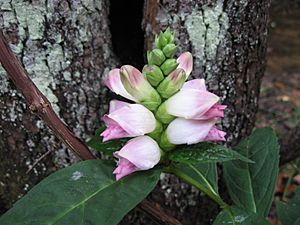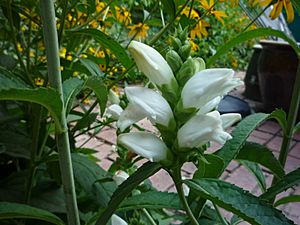White turtlehead or balmony facts for kids
Quick facts for kids White turtlehead or balmony |
|
|---|---|
 |
|
| Flowers | |
| Conservation status | |
| Scientific classification |
The white turtlehead (Chelone glabra) is a unique plant found across North America. It grows naturally from Georgia to Newfoundland and Labrador, and from Mississippi to Manitoba. This plant gets its common name because its flowers look like the head of a tortoise. In fact, the Greek word "chelone" means "tortoise." Long ago, there was even a nymph named Chelone in Greek stories. She was turned into a turtle as a punishment.
You can usually find white turtleheads in wet places. They love areas like forests near rivers and swamps.
Scientists have studied the white turtlehead's DNA sequence to understand its family tree. It is now known to belong to the Plantaginaceae family, which is also called the plantain family.
What the White Turtlehead Looks Like
The white turtlehead plant has strong, upright stems. Its leaves grow in pairs directly across from each other on the stem. They are simple, meaning each leaf is a single blade.
The flowers of this plant are white. They usually bloom in the late summer and early fall. These unique flowers are what give the plant its name.
White Turtlehead in Nature
This plant is very important for some animals. It is the main plant where the Baltimore checkerspot butterfly lays its eggs. This means the butterfly babies (caterpillars) eat the white turtlehead leaves to grow.
Deer also like to eat the white turtlehead. It's a popular snack for them! Other insects also use this plant for food. These include certain types of sawflies, like Macrophya nigra and Tenthredo grandis. A small beetle called a flea beetle, from the genus Dibolia, also feeds on the white turtlehead.



